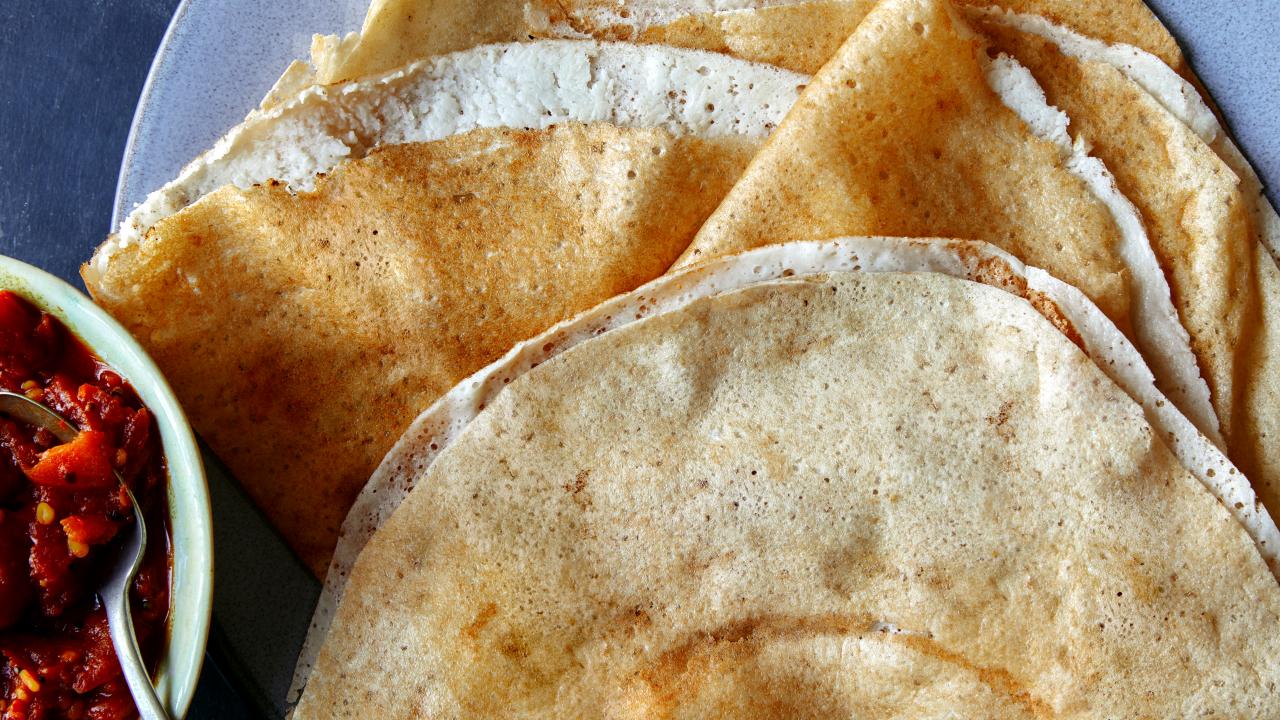Dosas
- Level: Intermediate
- Total: 1 day 17 hr (includes soaking and fermenting times)
- Active: 1 hr
- Yield: about 12 dosas
-
- Nutritional Analysis
- Per Serving
- Serving Size
- 1 of 12 servings
- Calories
- 165
- Total Fat
- 6 g
- Saturated Fat
- 1 g
- Carbohydrates
- 25 g
- Dietary Fiber
- 3 g
- Sugar
- 3 g
- Protein
- 4 g
- Cholesterol
- 4 mg
- Sodium
- 265 mg
- Level: Intermediate
- Total: 1 day 17 hr (includes soaking and fermenting times)
- Active: 1 hr
- Yield: about 12 dosas
-
- Nutritional Analysis
- Per Serving
- Serving Size
- 1 of 12 servings
- Calories
- 165
- Total Fat
- 6 g
- Saturated Fat
- 1 g
- Carbohydrates
- 25 g
- Dietary Fiber
- 3 g
- Sugar
- 3 g
- Protein
- 4 g
- Cholesterol
- 4 mg
- Sodium
- 265 mg
Ingredients
Easy Tomato Chutney:
Directions
- Rinse the lentils well in cold water and drain. Transfer them to a large mixing bowl, add the fenugreek seeds and 2 cups water and let soak at room temperature for a minimum of 4 hours and up to 8 hours.
- Drain the mixture and add to a blender with 3/4 cup fresh water. Blend until creamy with an ever-so-slight grittiness.
- Pour this mixture back into the large mixing bowl and add the rice flour, 1/2 teaspoon salt and enough water so it is the consistency of pancake batter. Mix well until evenly mixed and no lumps are remaining. Cover and let ferment until the batter has tiny bubbles, is frothy and has increased in volume, 12 to 36 hours (depending on the weather; see Cook’s Note).
- Add another 1/2 teaspoon salt to the batter and mix well. The final batter should not be too thin or thick; if it's too thick, add a little water, just enough to make the batter spreadable. A very runny batter will not result in crisp dosas, but a very thick batter will not be easy to spread. If the batter is very thin, you can add 1 to 2 tablespoons of rice flour to thicken. Transfer to an airtight quart container. This mixture will keep for up to a week in the refrigerator.
- To make dosas: Heat a nonstick pan or well-seasoned cast-iron pan over medium-high heat. (If your pan is not nonstick, rub a little oil into it. A nice traditional way of doing this is by using the flat side of half an onion.)
- Pour about 1/4 cup batter in the center of the pan and with the back of the ladle or the back of a small heatproof bowl or katori, spread it from the center outwards in concentric circles by applying a gentle pressure. Don’t worry if the batter does not spread very evenly. I prefer a little unevenness as that way parts of the dosa are crisp and parts are soft. Drizzle about 1 teaspoon of ghee or oil around the rim of the dosa and let the dosa cook until it becomes crisp on the thin parts and you can see it turning light brown, 2 to 3 minutes.
- Add the filling of your choice (if filling) to half of the dosa. With a metal or non-stick turner, flip the other half over and transfer to a plate. Repeat with the remaining batter. Dosas are best eaten right away. Serve with Easy Tomato Chutney, if desired.
Easy Tomato Chutney:
- Heat the vegetable oil in a medium saucepan over medium-high heat. Once hot and shimmering, add the mustard seeds. They should pop immediately. Lower the heat to medium and add the lentils, red pepper flakes and curry leaves if using. Be careful, as the curry leaves will sputter. Cook, stirring often, until the lentils turn golden brown, about 1 minute. Add the garlic and cook until it just starts sizzling; you do not want it to brown. Add the tomatoes, turmeric and 1/2 teaspoon salt. Increase the heat to medium high, bring to a simmer and cook, stirring occasionally, until the sauce has thickened, about 15 minutes.
- Add the jaggery or raw sugar and tamarind paste and cook until well mixed and the sugar has melted, 4 to 5 minutes. Add salt to taste. Remove from the heat and add the roasted sesame oil to finish, if using.
- Once cool, transfer the chutney to an airtight container and refrigerate. This chutney will keep for up to 2 weeks in the refrigerator.
Cook’s Note
Traditionally, whole skinless urad lentils are used for this recipe; they are white in color. However, I found that the split skinless urad lentils work just as well. In the summer, the batter ferments much faster than in the winter. If it's very cold or you are in a rush, you can ferment the batter in the oven with just the oven light on.
































